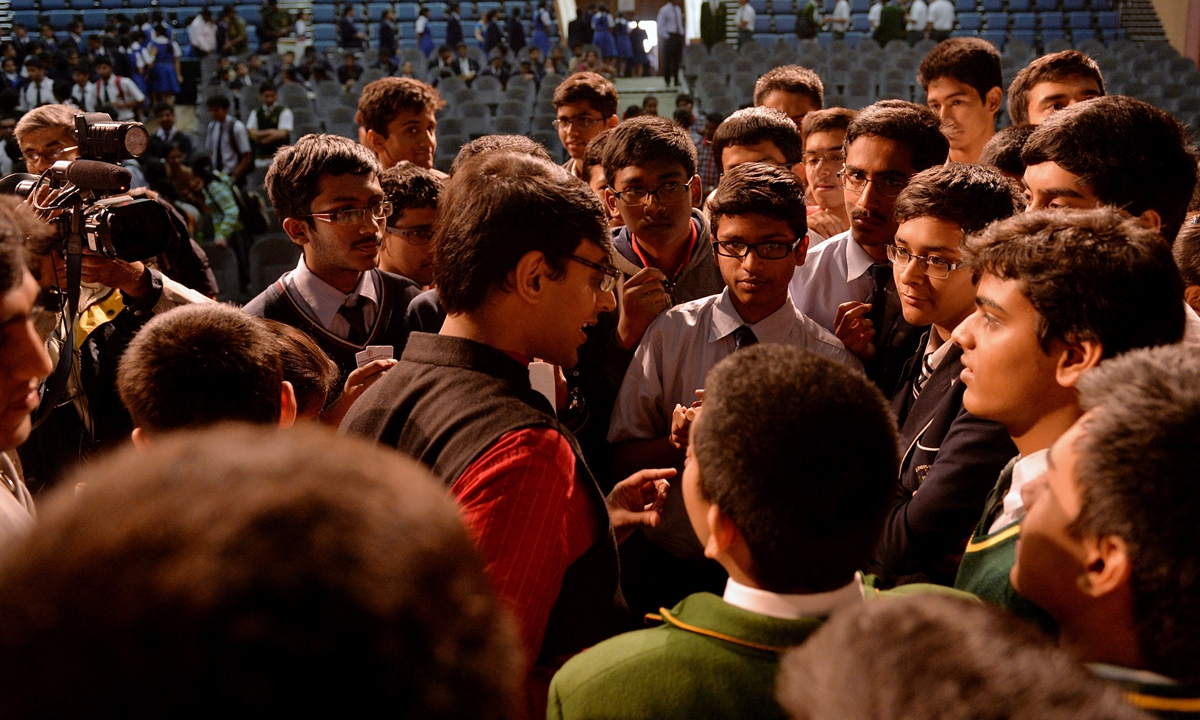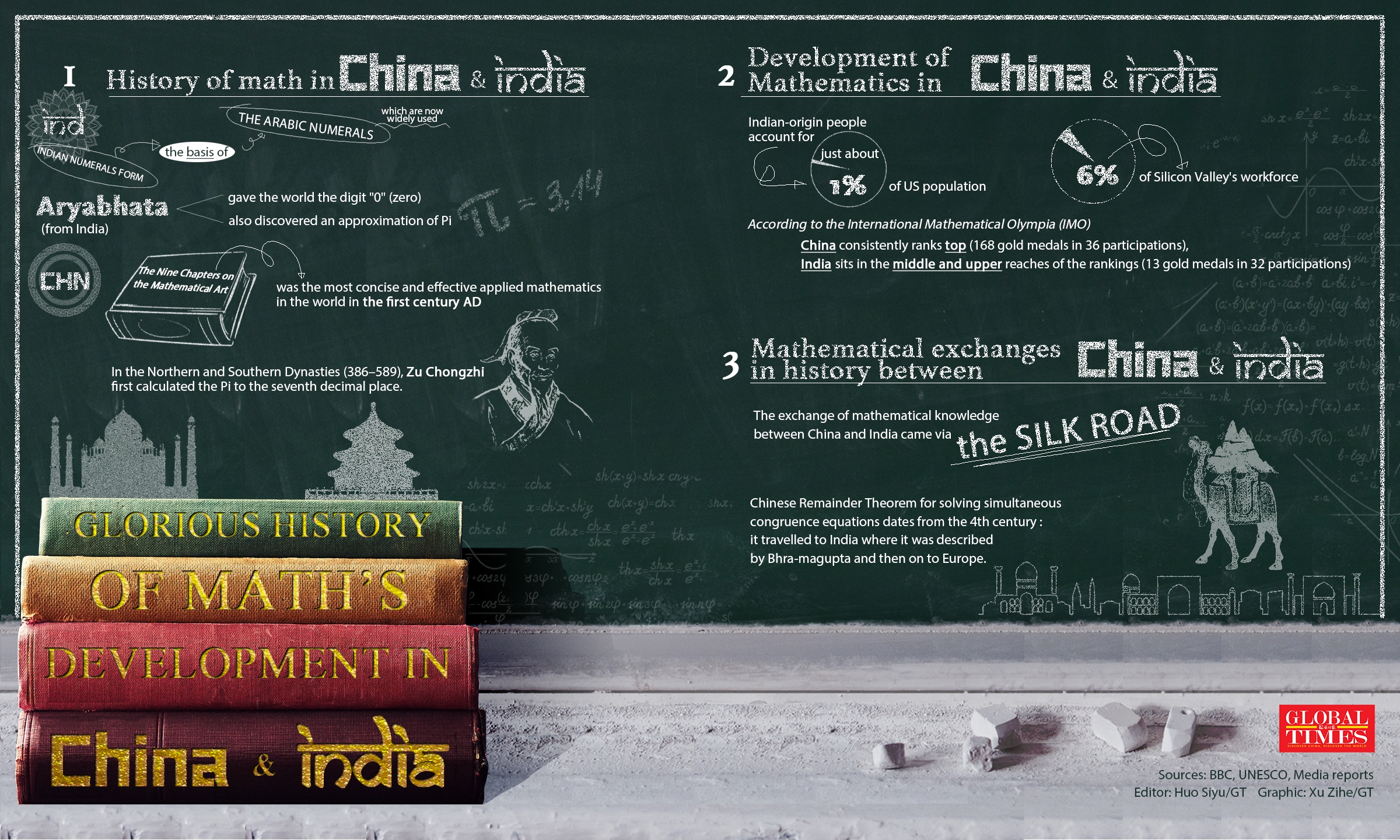
A mathematics professor at Princeton University, interacts with students of Bishop Cottons Boys School on the wonders and values of mathematics in Bangalore on January 21, 2015. Photo: AFP
If there is something that has the ability to trigger a huge surge of empathy between the Chinese and Indians, it would be mathematics.
People from these two countries have, for years, labored under the global stereotype that "they must be good at math." They have lived through the similar childhood "trauma" of memorizing the multiplication table, 9 multiplied by 9 for Chinese kids and 19 multiplied by 19 for their Indian peers. There is also a big number of gifted individuals from both China and India today working in IT, engineering, or other industries, enjoying the benefits they gained through mastering mathematics as they were growing up.
Recently, a TikTok clip comparing how the Chinese and Indians solve a multiplication problem in their different tricks went viral, igniting broad discussion on math techniques in both countries.
In the clip, a girl labeled "China" uses the more commonly used vertical form to solve 106 multiplied by 108, while the other girl uses an ancient Indian trick called "Vedic Mathematics," which solves the problem faster but is said to be not very "practical or universal."
There may never be a definitive answer to the age-old question - which trick is truly "better" - but many people actively joined the discussion, showing how important math is to people in both China and India.
"It's in our genes," said an Indian netizen, talking about math under the post of the battle between Chinese and Indian math tricks.
Even today, the two countries which have the two largest populations in the world still remain as giants in mathematics, whether in basic education, higher forms of research, or applications of mathematics in various fields.
Dominance in schools"What's 12 times 14? What's 9 to the third power?"
In a random question on the streets of Mumbai conducted by independent media company Asian Boss in August 2018, many local people were able to basically give the correct answer within three seconds.
"You should be good at math" is a deep-rooted concept in India. Math is definitely deemed one of the important subjects in India's school curriculum, Shamim Zakaria, an India journalist based in Beijing told the Global Times.
A similar concept is also rooted in China, where counting and calculating are considered a significant part of basic education.
In China, countless children are sent to after-school tutoring classes to learn abacus mental calculation, in which the 6- or 7-years-olds are able to calculate eight-digit numbers by heart.
Some studies suggest Chinese syllables are simpler for numbers, thus the language has a natural advantage in math.
The advantages of mathematics accompany the growth of Chinese and Indian children.
In terms of positions placed by each country annually in the International Mathematical Olympia's (IMO) unofficial mark ranking published on the IMO official website, China is always at the top, while India is in the upper middle, ranging from 7th to 52nd.
China has finished first for three years in a row as of 2021. In the past 30 years, China has placed first 20 times. And among the multi-ethnic students who make up the US delegation, most of them are of Chinese and Indian descent.
Albert Liu, a Chinese PhD student at the Department of Statistics at the University of Washington, believes that the IMO results are a more objective reflection of the level of competition in math by secondary school students in China and India.
"It is a normal phenomenon for the Chinese and Indians to fill up the math department," Chang Keying, a postgraduate student at University College Cork in Ireland majoring in Statistics, whose classes are comprised of half Chinese and a quarter Indian students, told the Global Times.
Chang said her Indian classmates have talked to her about how competitive India's education system is with its overpopulation. "The ratio of college enrollment in India was only 27.1 percent in 2020, and mathematics is a subject in which students achieve high admission scores in each university, so the basic level of students is naturally higher than others," she noted.
Chang pointed out that Chinese students' advantage in mathematics lies in their rigor and enquiring minds; Indian students are more innovative and dare to express their views.

Glorious history of math's development in China and India.Graphic:Global Times
Abacus and Vedic mathThrough China and Indian's long and glorious history of cultural ties, mathematics has left many legacies and legends, becoming a treasure for people in both countries.
In India, the development of mathematics has a long history and is inextricably linked to religion. The first use of mathematics in the Indian subcontinent was in the Indus valley and dates as far back as 3000BC. Under the influence of the Brahman rituals, mathematics was often used in architectural and astronomical studies.
In the Vedas, the classical texts of Brahmanism and Hinduism, there are a number of computational problems on geometry and algebra, including the classical Pythagorean Theorem, theorems of triangle similarity and congruence, and so on. These theorems were proved in Euclid's Elements in 300BC, but they were discovered in ancient India more than 700 years earlier.
In the middle of the 7th century, Indian notations spread to the west and were then improved upon by the Arabs, and introduced to Europe to become the current widely used Arabic numeral system.
And the formulation of the use of the digit "0" and calculating the approximation for pi (π), are still a source of pride for Indians today.
China also has a long history in math. Experts point out that among the four major ancient civilizations, Chinese mathematics has enjoyed the longest period of prosperity.
As early as in the Shang Dynasty (1600-1046BC), there was already a complete decimal system. The
Shu Shu Jiu Zhang (Nine Chapters on the Mathematical Art), which appeared around the 1st century AD, was the first mathematical monograph in China, and the most concise and effective applied mathematics in the world at that time. Zu Chongzhi, a distinguished mathematician and astronomer of the Northern and Southern Dynasties (386-589), first calculated circumference to the seventh decimal place.
To commemorate the glorious mathematical achievements in Chinese history, in December 2020, China named a quantum computing prototype that can detect a maximum of 76 photons "Jiuzhang." In May 2021, China named the 62-bit programmable superconducting quantum computing prototype "Zu Chongzhi."
Mathematical exchanges in history between China and India were along the Silk Road.
In ancient times, China would export goods to India and India exported Buddhism and mathematics to China, said Amartya Sen, a Nobel Prize-winning economist from Bangladesh.
After Buddhism was introduced into China, a large number of Chinese scholars went to India to study Buddhism, mathematics, and science, and India was also interested in China, Sen noted. During the Sui and Tang dynasties, several Indian mathematicians and astronomers held senior positions in Chinese scientific institutions, and an Indian scientist, Gautama Siddha, even became the Director of the official Board of Astronomy of China in the 8th century.
The Chinese Remainder Theorem for solving simultaneous congruence equations dates from the 4th century AD and travelled to India where it was described by local mathematician and astronomer Bhra-magupta and then on to Europe.
Are they still leading today?
However, experts point out that while China and India are widely considered to be math powerhouses, both countries are in fact lacking in the frontiers of mathematics.
For example, no Chinese or Indian national has ever appeared among the historical winners of the Fields medal, while only two winners of Chinese descent have snagged the coveted title. No one of Indian descent has won the award to date. According to statistics, the vast majority of China's previous Olympic gold medalists have not gone on to pursue math-related careers. China's best mathematics school, Peking University's School of Mathematics, had 96 master's graduates in 2018, including 52 with guaranteed employment. Of those 52, 27 or more than half, chose finance; while only four chose research units.
China's major top math talent is going to the finance sector, while India's math talent tends to choose IT houses, observers say.
Liu pointed out that in the US, for a long time, top math students from China and India were prominent in school, but after graduation, they were mainly absorbed by big tech and the financial sector, with only a handful choosing to pursue further studies in academic fields.
According to Liu's observation, who has interned at both internet and financial enterprises in the US, there are more Indians in internet companies, and many of them have even become senior executives, just like Indian-born American Satya Nadella who leads Microsoft and Sundar Pichai who is the head of Alphabet; while in the field of finance, especially in the field of quantitative analysis, which is more related to mathematics, the percentage of outstanding Chinese nationals is very high.
"Indians are better at math and have better communication skills, while the relatively 'quiet' Chinese are more likely to shine in quantitative financial analysis, a field that relies purely on technical and strategic skills to win," Liu said.
"Traditionally parents in Asia have a tendency to emphasize the importance of math and science so their children can become 'good doctors or engineers,'" Zakaria said, noting that currently, this way of thinking is rapidly changing in India.
This trend has changed in China in recent years. More top mathematicians have emerged in China, with several winning top international math awards other than the Fields Medal.
Currently, a younger generation of Chinese mathematicians is already on the rise, Roy Wang, a PhD candidate studying at Caltech in California, told the Global Times.
Wang, who graduated from the School of Mathematical Sciences at Peking University, said the Chinese public's emphasis on mathematics and the solid, basic mathematics education implemented by the Chinese government have, in tandem, laid a very solid foundation of knowledge for Chinese people in the field of mathematics, research, and application.

Children visit the exhibition hall of Representational Mathematics Laboratory at the Beijing Science Center in September 12, 2021. Photo: VCG
"I believe the Chinese are exceptionally gifted in mathematics and I would attribute it to the overall education system. Besides, I have seen that Chinese students take math very seriously and practice diligently," Zakaria said
The Chinese are a diligent people who are extremely patient when it comes to enduring the dullness of monotonous practice, he noted.
Having experienced the comprehensive knowledge system training and the relatively intense pace of study in China, we adapted very quickly after studying abroad, Wang said. "For the new subject, compared with the students in other countries who have to do some work to supplement their knowledge in their blind areas, we can get started directly and move forward quickly," he said.
The cutting-edge technology industry has also become more focused on mathematical talent with Huawei's founder Ren Zhengfei publicly stating that the most important talent at Huawei is its mathematicians.






